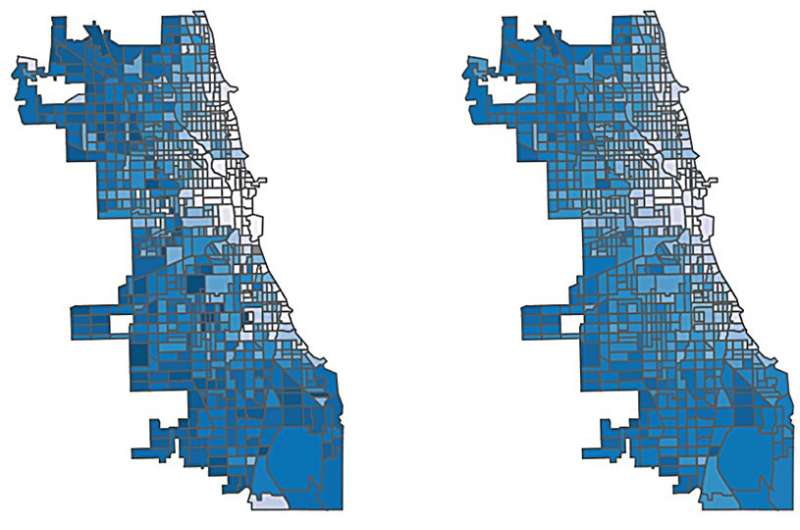This article has been reviewed according to Science X's editorial process and policies. Editors have highlighted the following attributes while ensuring the content's credibility:
fact-checked
trusted source
proofread
Study estimates nearly 70% of children under six in Chicago may be exposed to lead-contaminated tap water

A new analysis led by researchers at the Johns Hopkins Bloomberg School of Public Health estimates that 68 percent of Chicago children under age six live in households with tap water containing detectable levels of lead.
For their analysis, the researchers used machine learning, an artificial intelligence technique, to gauge likely levels of lead in tap water in households across Chicago based on an existing dataset that includes results from 38,385 tap water tests taken from 2016 to 2023. The tests were from households that had registered for a free self-administered testing service for lead exposure.
The threshold the researchers used was the lowest detectable level of lead in the water tests, one part per billion—roughly the equivalent of a half teaspoon of water in an Olympic-size swimming pool. More than two-thirds—69 percent—of the tests exceeded this level. From this, the machine learning model predicted lead-contaminated water in 75 percent of residential city blocks, covering 68 percent of Chicago children under 6.
The Environmental Protection Agency's current "action" level for lead in drinking water—the point at which a municipality must take additional steps—is 15 ppb. The analysis found that 9 percent of tests had lead levels over 15 ppb. The analysis also found racial inequities in exposure levels and testing rates.
The findings were published in JAMA Pediatrics.
Lead is considered a serious environmental toxin, especially for children, with no "safe" exposure level. Lead pipes were used and often required before they were banned in the U.S. in 1986. Many cities still use lead water pipes that were installed prior to their ban. Chicago has more than any other U.S. city, an estimated 400,000 lead pipes that supply water to as many as 2.7 million people.
Across the U.S., more than 9.2 million households get water through lead pipes and service lines, according to the Environmental Protection Agency.
The EPA has proposed that U.S. cities replace all lead water service lines within 10 years. Under the proposal, Chicago would get 40 years to comply, given the disproportionate burden its water infrastructure poses.
"The extent of lead contamination of tap water in Chicago is disheartening—it's not something we should be seeing in 2024," says study lead author Benjamin Huynh, Ph.D., an assistant professor in the Bloomberg School's Department of Environmental Health and Engineering.
For their study, Huynh and colleagues set out to quantify the exposure faced by Chicago children under six.
The researchers began with a publicly available dataset from the Chicago Department of Water Management that contained 38,385 tap water test results for lead that participating Chicago households had taken from January 2016 to September 2023. The results covered about 36 percent of residential blocks in the city.
The researchers then combined these data with U.S. Census and other official data on block-by-block demographics and used machine learning techniques to extrapolate—from the partial coverage of the tap water test results—the likely block-by-block risk of having lead-contaminated water.
The analysis also used the city's self-reported household survey data to estimate that 19 percent of exposed children—about 129,000 across the city—used unfiltered tap water for drinking. Using modeling, the researchers estimate that exposed children have approximately twice the amount of lead in their blood as unexposed children do.
The analysis suggested there are racial disparities in lead exposure in Chicago. For example, a 10 percentage-point increase in the Hispanic population was associated with an 11.2 percent increase in the chance of lead contamination. The analysis also suggests that Hispanic residents of the city were the least likely to drink unfiltered tap water, with 12 percent responding that they did. By contrast, 32 percent of white residents reported using unfiltered tap water as their primary drinking water source.
As for testing rates, Black and Hispanic populations were less likely to be tested for lead exposure, suggesting gaps in outreach. Ten percentage-point increases in Black and Hispanic populations were associated with 3- and 6-percent decreases, respectively, in chances of being tested for lead.
The authors note that the study has several limitations. The data on lead testing were anonymized at the block level, so the researchers were not able to use household-specific data. The researchers did not have access to city-wide pediatric health records, and so had to model the health impacts of lead exposure instead of directly estimating them from data.
More information: Benjamin Q. Huynh et al, Estimated Childhood Lead Exposure From Drinking Water in Chicago, JAMA Pediatrics (2024). DOI: 10.1001/jamapediatrics.2024.0133. jamanetwork.com/journals/jamap … /fullarticle/2815850




















